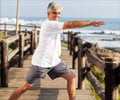Regular physical activity cuts anxiety and depression risk in patients with chronic obstructive pulmonary disease (COPD).
Highlights
- Feelings of anxiety and depression are common in patients with chronic obstructive pulmonary disease (COPD)
- Low physical activity (PA) is a critical feature of COPD
- Higher PA is linked to reduced risk of anxiety and depression in COPD patients
Chronic obstructive pulmonary disease (COPD) includes respiratory tract disorders that cause obstruction to airflow. These are chronic bronchitis, emphysema and small airway disease. The main cause of COPD is long-term exposure to substances (cigarette smoke, second-hand smoke) that irritate the lungs. There is no cure for COPD.
COPD Statistics
- In 2012, more than 3 million people died of COPD
- More than 90% of the deaths occur in low and middle-income countries
- COPD affects an estimated 24 million people in the US
Research team selected 409 patients from primary care practice in the Netherlands and Switzerland.
The study was conducted by Drs Milo Puhan, Anja Frei, and Tsung Yu, University of Zurich, Switzerland, and Dr Gerben ter Riet, University of Amsterdam, the Netherlands.
During the follow-up of the study, the patients reported their comorbidities under the following categories
- Cardiovascular
- Neurological
- Hormonal
- Musculoskeletal
- Cancer
- Infectious diseases
Higher levels of physical activity were associated with the following for over the next 5 years Depression and Anxiety in Patients with COPD
Depression and anxiety are challenging to spot and treat in COPD patients because their symptoms overlap with those of COPD. Untreated depression and anxiety can have a deleterious effect on physical functioning, increasing fatigue in COPD patients.
Research published in European Respiratory Review suggests that pulmonary rehabilitation (exercise), smoking cessation, psychotherapy and antidepressant drug therapy were found to reduce anxiety and depression symptoms in patients with COPD.
Study conducted by Martijin et al revealed that exercise training as a part of pulmonary rehabilitation programme makes a difference in COPD patients. The research team did not observe any statistically significant associations of PA with the other categories of comorbidities.
The authors conclude: "In COPD patients, those with high PA are less likely to develop depression or anxiety over time. PA promotion programs may be considered to lower the burden of mental disorders in COPD patients."
Benefits of Physical Activity
- Controls weight
- Strengthens Heart and Improves Lung Function
- Reduces risk of heart disease, diabetes, cancers
- Improves mental health and mood
- Boosts Energy
- Promotes better sleep
- Extends life expectancy
















